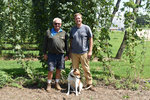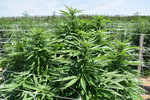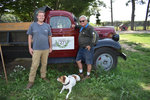



The story of how Route 27 Hemp Yard came to be is an interesting tale, involving the CBD craze, a United States bill, and a family that originally sought out to farm hops.
Five years ago, Ryan Andoos was looking for farmland so he could grow hops, the plant that gives beer its bitter taste. He’d spent a chunk of his young but blossoming (pun intended) career working on a hops farm in New Zealand, and he wanted to use his degree in landscape design and horticulture on a project back home on Long Island.
Sure, he’d spent his time traveling the world, putting his knowledge to work at the family botanical garden in Norway and at the Claude Monet Museum in Giverny, France, but home is where the heart is, right? That’s where Mark (“Uncle Mark”) Carroll comes in (Carroll is Andoos’s uncle). Carroll’s friend was selling a plot of farmland in Moriches, tucked away from the hamlet’s suburban neighborhoods in the middle of a swath of sod farms. So, Andoos and Carroll partnered and began tilling the land, once a nursery growing rows of trees and shrubbery, and turned it into a hops farm.
For two years, Carroll and Andoos exclusively farmed hops, cultivating the perennial plants in 1,000-foot runs, while steadily growing another crop: customers, who purchased the hops for craft beer-making in Long Island’s local breweries, enticed by the hops being eco-friendly and grown on Long Island, and the fact that they could come to the farm and talk beer. By this time, growing hemp in New York State was legal, following a 2014 farm bill. But the duo hadn’t yet contemplated the option for themselves—until someone brought it to their attention.
“A friend said to me, ‘Why don’t you try hemp, it would go along well with the hops?’ and so we did,” said Carroll.
Many aspects of the plants are similar, beginning with the terpenes, which Andoos explained are the aromatic compounds that give a plant its signature scent. Terpenes don’t just exist in hemp and hops—they exist in lavender, pine, rosemary, lemon balm and other plants, herbs and even animals.
“The same terpenes that flavor your beer are the same terpenes, in different percentages, that flavor your CBD flower,” he said.
Now, three seasons into the hemp-growing business, Carroll and Andoos look back on their decision to farm hemp as a time similar to California’s gold rush or the Silicon Valley startup craze of the early aughts.
“It was like a land rush deal when everyone started,” said Carroll.
The only difference was that most people didn’t strike it rich. Also, Carroll said, many of his competitors didn’t anticipate the difficulty of growing hemp.
“A lot of people thought they’d get rich quick with it, and then they bailed out when they realized that wasn’t going to happen,” he said. “There’ a lot of labor involved in this plant. A lot of time and effort and money. Not that fruits and vegetables are any easier to grow—but getting this plant to market is very time-consuming and very expensive.”
To understand the expense in growing it, Carroll explained how the plant is farmed. Hemp is an annual plant, meaning it grows from seed to plant within a 90-to-120-day period, graduating into the finished product within about five months. Route 27 Hemp Yard grows a dozen different strains of the plant each year. This year’s batch includes: Hercules, Peach Goliath, Super Sour Space Candy and Hawaiian Haze. Though, Andoos can’t take credit for the creative names.
“A breeder names the seeds,” he said.
During the six-week period known as harvest, 12 to 18 workers spend long days out in the hemp fields cutting the plant by hand. No chemicals or pesticides ever touch the plant, which adds to its costly nature. Also adding to the steep price of cultivating hemp are unanticipated events. Last year’s harvest saw catastrophe when rain drenched the eastern bit of Long Island seven days in a row, and they lost nearly half of the entire year’s production to bud rot.
After all of the work, time, and effort in farming the plant, the end result can prove to be a lucrative business. In addition to selling CBD products to 80 local smoke shops, Route 27 Hemp Yard also sells on their website. They have beauty products, including CBD lip balm, soap and lip scrub. They also sell smokable CBD flowers in various sizes, including 1/8, 1/4 and 1 ounce, as well as pre-rolled cigarettes containing CBD.
Asked how business is going, Carroll said, “Every day we’re at the post office.”
Of all the products they have, Carroll said the CBD cream, which is a full-spectrum topical cream, is their best seller. It incorporates all-natural ingredients and 1,000 mg of CBD.
“The cream is really where it’s at. We get a lot of seniors and people of all ages that want this cream,” he said.
The decision to grow hemp is one Andoos and Carroll both said they’re happy with. Both men said the benefits of the hemp plant are exponential, from the plant’s benefit in oxygenating the soil, to the benefits CBD has on human health.
“They’re finding out more and more every day. The hemp plant is just an amazing plant; it really is. Now that I’m in it, it really is a cool plant,” added Carroll.
Comments
No comments on this item Please log in to comment by clicking here